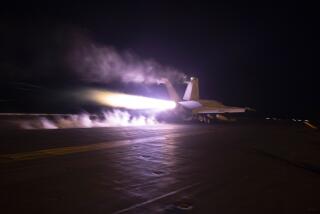The Day in the Gulf
- Share via
* SOVIET INITIATIVE: Soviet President Mikhail S. Gorbachev offered a plan for a political settlement of the Gulf War to Iraqi Foreign Minister Tarik Aziz, visiting Moscow, and to President Bush. A Soviet spokesman said the plan contained “purely political measures” but gave no details. The Bush Administration withheld any comment on the substance of the Soviet effort.
* U.S. SHIPS HIT MINES: For the first time in the war, U.S. ships in the Persian Gulf were damaged by mines. Four people were injured aboard the Tripoli, a helicopter and troop carrier based in San Diego, when a blast apparently from a floating contact mine blew a hole in the vessel. Later, the missile cruiser Princeton, from Long Beach, hit a mine. There were three injuries.
* PILOT RESCUED: Iraq shot down an American F-16 jet over Kuwait. An American helicopter crew, with fighter jets overhead, made a daring rescue of the downed pilot, flying 40 miles into Kuwait to pluck him to safety. The plane was the 21st the United States has lost in the Gulf War.
* ACTION AND TOUGH TALK: The allies launched heavy air strikes on Iraqi troop positions as well as initiating artillery duels across the Kuwait border. At military headquarters in Riyadh, the Saudi Arabian capital, the U.S. Command sounded ready for either a ground war or an extended all-air offensive. “It’s probably to our advantage to have the air campaign go on,” said Marine Brig. Gen. Richard I. Neal, “because . . . every day our aviation elements are in the air, they’re inflicting casualties.”
* CLOUDY SKIES: Partly cloudy weather cut into the number of Operation Desert Storm air sorties, reducing them to 2,400 in 24 hours, down from the usual 2,600 or 2,800 of recent days, the U.S. Command said.
More to Read
Sign up for Essential California
The most important California stories and recommendations in your inbox every morning.
You may occasionally receive promotional content from the Los Angeles Times.










